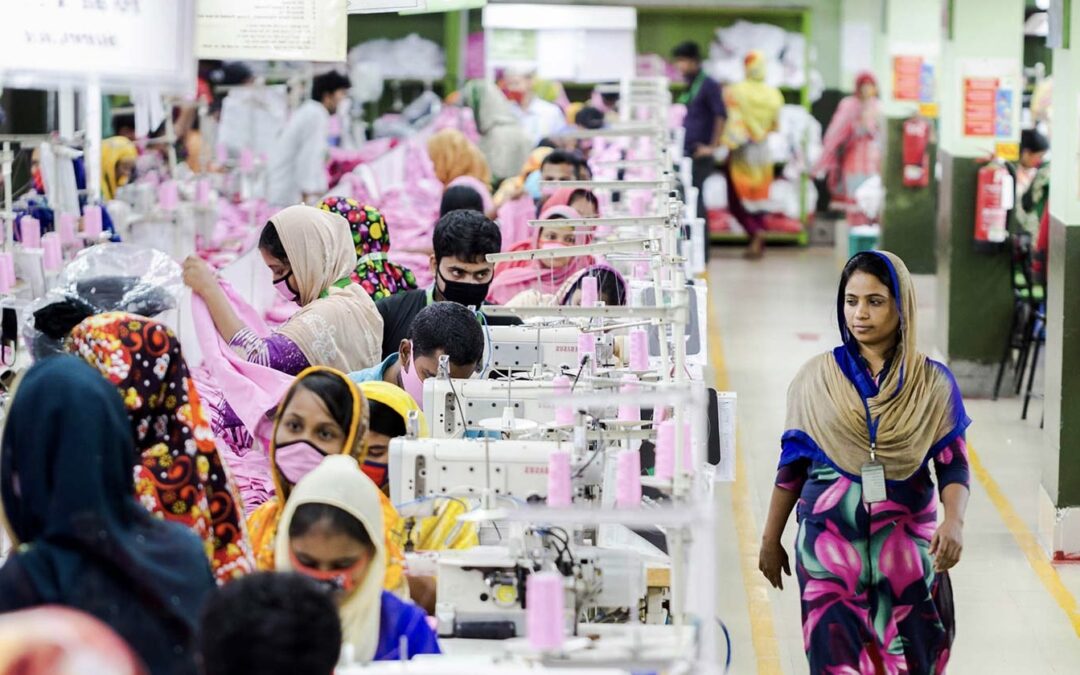The RMG sector has been a significant driver of economic growth since the early nineties in Bangladesh. The sector accounts for more than 80% of Bangladesh’s export earnings and employs around four million workers relying on low-cost labor as a competitive advantage in the global market. However, the sector faces some structural issues which endangers its competitiveness in the long run. In this context, the sector requires in-depth examination regarding these issues in the context of competitor countries and the recent socio-political advancements for undertaking key takeaways.
According to various studies, the RMG sector’s development has been facilitated by a “political settlement” between government and business elites, aligning economic benefits for owners with political stability through employment generation. This settlement has supported keeping wages low to maintain Bangladesh’s competitive advantage. However, this has also cemented a cycle of labour unrest, as workers’ demands are persistently sidelined, and minimum wage adjustments rarely match inflation or living costs. International attention on Bangladesh’s RMG sector peaks only during tragic incidents, such as the Rana Plaza collapse in 2013, but systemic issues persist in daily operations. For starters, the ongoing labor unrest, which has been a chronic issue for the past decades, highlights the fragility of this sector. Workers have protested against low wages, unsafe working conditions, and the suppression of their rights, leading to factory closures and disruptions in production. This unrest is exacerbated by a backdrop of political instability, with an interim government tasked with the gigantic task of maintaining order and addressing the root causes of discontent among workers.
The RMG industry started with small factories as it was easy to set up a small garment factory: one could establish a factory by renting space, buying 50–100 sewing machines, wiring up the factory for electricity, hiring and training the workers, getting a contract for a small order of simple garments, and going to work. However, even after four decades, long working hours, low wages, lack of regular contracts, and systemically hazardous conditions persists in the sector. Absence of contracts helps the owners not to provide proper compensations while laying off workers, or work-related injuries, even deaths. Furthermore, arbitrary cases in times of protests hampers way forward to peaceful collaborative solutions. Trade unions face considerable repression, with union organizers often experiencing intimidation or violence. This suppression hinders workers from securing better wages or improved working conditions, leading to a fragile industrial relations climate. The inability of unions to advocate effectively leaves workers vulnerable and strengthens the employer’s position, as reflected in the minimal improvements in wage structures over the years. Furthermore, taking advantage of the lack of strong unions, vested interest groups driven by political motives manipulates the conflicts.
Another major issue facing the industry is the low productivity of workers which the sector mitigates through longer working hours. This low productivity refers to the lower skill level due to lower education level and lower level of automation in the production process. Currently, less than 15% of operations in Bangladesh’s RMG sector are mechanized, which is significantly lower than that of competitors like Vietnam. On that note, Bangladesh’s investment in research and development (R&D) within the RMG sector is particularly low, with factories allocating only about 2% of their expenditures to research and development activities. Moreover, many mid-to-senior management personnel in this sector lack the necessary skills to uplift efficiency in critical production areas, such as sewing. This skills gap prevents the workforce from achieving optimal productivity levels. On the contrary, Vietnam’s workforce is often considered more skilled due to better training and educational systems, which contributes to its ability to produce higher-value garments compared to Bangladesh’s focus on basic apparel.
While looking at the competitors further, Cambodia’s garment sector faces similar challenges in terms of wages but has made strides with its structured, tripartite minimum wage adjustment system. Regular wage reviews involving government, employers, and unions help in creating a more balanced environment. Although there are still challenges, the presence of structured negotiations has allowed for more stable industrial relations compared to Bangladesh. Vietnam offers relatively higher wages and has better productivity, in part due to a strong focus on efficiency over long working hours. This shift attracts a more stable workforce and minimizes excessive unrest, positioning Vietnam as a key competitor. Indonesia has implemented a wage adjustment formula based on GDP and inflation, which is more predictable and aimed at reducing labor disputes. This method is a potential model for Bangladesh to consider, as it bases wage adjustments on empirical economic data, although it is not without criticism from unions.
Moving forward, first, the sector ought to establish stronger, more autonomous trade unions, which would be essential for creating balance in wage negotiations and peaceful collaborative solutions. This shift might include establishing wage-setting boards with true worker representation to foster more regular wage adjustments in line with living costs. Second, emulating Indonesia’s model, where wage adjustments align with GDP and inflation, could make wage changes more transparent and prevent abrupt demands for wage hikes due to inflationary pressures. Third, developing a robust regulatory framework and investing in compliance mechanisms can protect workers and minimize the reputational risks tied to poor labor conditions. This could include strengthening Bangladesh’s Department of Inspection for Factories and Establishments (DIFE) to enforce safety standards more effectively.
Addressing the underlying causes of unrest and mitigating the structural issues are essential for restoring confidence among international buyers and ensuring the sector’s long-term viability. Without significant reforms and a commitment to stability, Bangladesh risks losing its competitive edge in the global apparel market.
This article was first published in the November, 2024 edition of the Thinking Aloud



RECENT COMMENTS